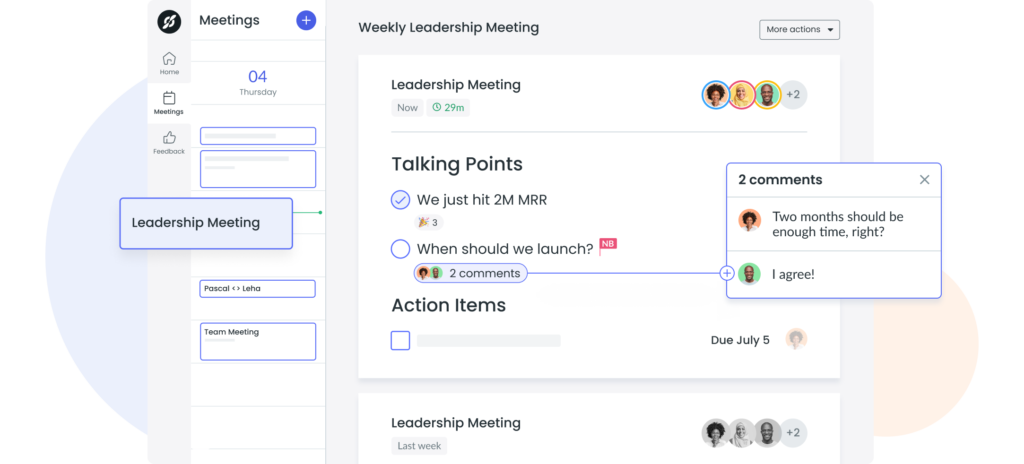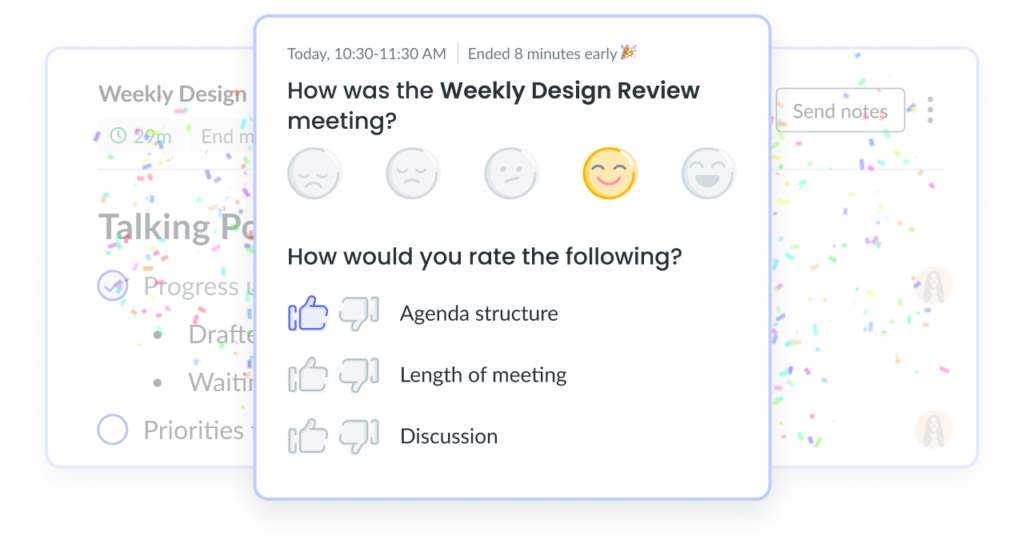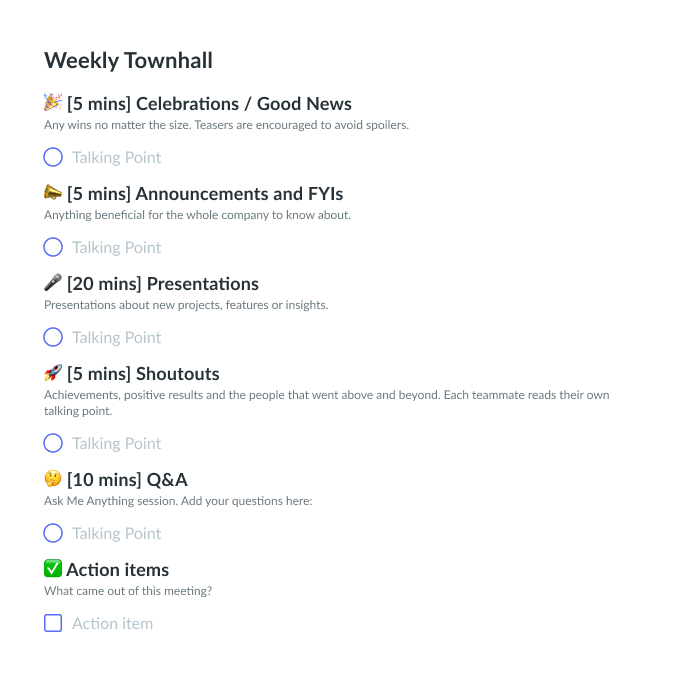How to Run an Effective End-of-Year Town Hall
Engaging your employees in an end-of-year town hall helps with alignment and motivation. Learn end-of-year town hall best practices here!
According to Gallup’s research, highly engaged employees can reduce turnover by 18%, decrease quality defects by 48%, and increase profitability by 23%, among many other benefits. In other words, investing in highly engaged employees helps your organization succeed much more than any other investment. Running an end-of-year town hall is a strong example of an organization-wide activity that can help your employees feel more connected to high-level strategic business goals for the company and get aligned on working towards those goals.
- What is an end-of-year town hall?
- Why are town hall meetings important?
- End-of-year town hall best practices
- Free town hall meeting agenda template
What is an end-of-year town hall?
A town hall is a meeting for your entire organization to come together, review results on projects across the company, and announce goals for the future. This meeting is almost always led by C-level executives—likely by the chief executive officer (CEO). As such, this meeting presents a great opportunity to encourage employees to ask questions about the future of the company and get insights into revenue target goals or product roadmap plans. It’s a very important meeting for making the wider company feel involved and aligned.

Run delightful town hall meetings
Increase meeting engagement and productivity with a collaborative agenda that the whole team can contribute to. Try using a tool like Fellow!

Why are town hall meetings important?
- They allow you to reflect on your team’s accomplishments
- They set your team up for the upcoming year
- They help you collect feedback about the year
- They provide an opportunity to thank employees
1They allow you to reflect on your team’s accomplishments
A lot happens in a year! And there’s a good chance that by the time the end of your fiscal year comes around, your team may have forgotten all of the accomplishments that they made in the first and second quarters. Any visual presentations of results—like pictures of successful campaigns or charts of revenue or productivity improvements—are helpful in demonstrating these successes to other teams that may not have otherwise heard of these projects.
2They set your team up for the upcoming year
Informing your team on the strategic objectives and key results (OKRs) that have been created for the company will help your team create their own OKRs, which will align with the organizational OKRs. When sharing the company-level OKRs, be clear with your employees and managers about why these specific goals were chosen and generally what is expected of each department to support these goals.
3They help you collect feedback about the year
As you have your full team in one place at the same time, it’s an ideal opportunity to get feedback about the past year. This is a great opportunity to share employee feedback survey results or answers about any experiments that the company entered into in the previous year—for example, was there a new technology the company attempted to create or a new channel to begin marketing in? Talk about it! Encourage employees to step up and ask questions or feedback as much as possible in this meeting.
4They provide an opportunity to thank employees
Many hands make light work. Take an opportunity to thank your employees for their hard work over the past year. You can show this thanks in any way you’d like, but showing praise has been proven to increase employee productivity and reduce turnover.
End-of-year town hall best practices
- Celebrate your team’s wins
- Set and discuss goals for the upcoming year
- Thank your team for their hard work
- Use meeting management software
- Take meeting minutes
- Wish your attendees happy holidays
- Ask for meeting feedback
- Encourage shoutouts
- End on a positive note
- Leave time for questions
1Celebrate your team’s wins
Start your meeting off on a positive note by celebrating all the successes, big or small, that the team contributed to over the past year. Breaking down these wins by quarter or department will give you a comprehensive look at successes over the year and ensure that everyone’s wins are accounted for. If you’re part of a smaller organization and have the time, you might consider opening up a “shout-out” period where people can contribute individual stories of successes to give praise to another employee or team.
2Set and discuss goals for the upcoming year
Defining super clear OKRs for your organization will help each department build realistic OKRs that are in line with the overall strategic goals for the business. It’s helpful to get as much feedback from other teams as possible to help shape goals that are achievable and valuable for the growth of the organization. Any opportunity to quantify goals and walk employees through your decision-making process will make it easier for them to understand and align with the goals.
3Thank your team for their hard work
A little bit of appreciation goes a long way. Things like shoutouts and presentations of successful efforts are one way to display appreciation for your team. Any opportunity to recognize specific, individual extraordinary efforts is helpful for driving motivation and purpose on your team. It makes individual teams and employees feel noticed for their work and more likely to continue working at the same high caliber going forward. Displays of appreciation can also be more tangible, such as a year-end bonus or team party.
4Use meeting management software
There is a lot of content to discuss in an end-of-year town hall meeting. Organizing your meeting agenda using a tool like Fellow can help your meeting hosts cover all high-priority topics, track efficient uses of time during the meeting, and list action items resulting from the meeting with ease. All attendees can then access the meeting notes afterwards and view the meeting recording if it’s available and added to the Fellow notes.

5Take meeting minutes
Meeting minutes are essentially the notes of what occurred during the meeting. Taking these notes is important to remember who attended, who presented, the time and date of the meeting, the topics discussed, and the action items following the discussions. In the weeks and months after the town hall, your employees can check in on the meeting notes to review strategic objectives to ensure they are aligning well to them. These minutes can also be used to keep teams accountable or inform team members who were not able to join the initial call.
6Wish your attendees happy holidays
Many employees celebrate various holidays near the end of the year. In North America, Christmas is one of the most popular holidays celebrated by employees and organizations. However, it’s important not to forget other holidays celebrated by your team, like Hanukkah, Las Posadas, Kwanzaa, Three Kings Day, and the New Year!
Encourage your employees to take their holiday time to rest and spend time doing what they love with those who are important to them. Know that well-rested employees will be happier, more engaged, and more excited in their work once they return. Set a standard for your employees to take this time fully off from work unless specific roles require other on-call duties.
7Ask for meeting feedback
Getting meeting feedback is another way to generate information that you can use to improve your meeting operations. For example, meeting feedback will help you know if you prepared well enough for the meeting, if the agenda was structured efficiently, or even if the range of topics covered was relevant for the meeting purpose. By collecting meeting feedback, you also provide employees with another opportunity to express their thoughts and opinions, making them feel more connected and purposeful within the organization.
With Fellow, you can promote a culture of feedback by gathering anonymous feedback after each meeting.

8Encourage shoutouts
End-of-year town halls, when everyone is together in the same (virtual) room, are a great time to encourage shoutouts. Try opening the floor to team members to unmute or speak up to praise an individual or group who went out of their way to support a successful activity. Encouraging team members to give praise to others within the team builds a strong team dynamic and helps build trust. It’s also a good opportunity for each department to learn more about what other teams are working on and the great contributions that they’ve made towards the company’s common goal.
9End on a positive note
If you have an exciting announcement (for example, extra “surprise” day off for your team to celebrate their successes), saving this for the end of the meeting can be a fun way to close out the call and leave your employees feeling positive about their experience at the company. Other positive notes that you could use at the end of your meeting include sharing:
- A collection of testimonials from happy customers, to show how successful the work has been so far
- A presentation of photos from team-bonding events over the past year, to connect the team together
- A collection of memes that are relatable and appropriate to the business, to add a sense of humor to the work being done
- Industry statistics that demonstrate a positive future ahead for the company
10Leave time for questions
As with any meeting, it’s very likely that attendees will have questions. Since town hall meetings usually have a high number of attendees, it makes sense to add more question time into these meetings than other meetings. This is especially true if you are launching new initiatives that the company has never seen before, or if you are taking a drastic change in strategy. At minimum, you should leave 15 minutes for questions, but this might be extended if your meeting topics need more discussion time to properly address all uncertainties. If you cannot afford the additional discussion time at the end of your town hall meeting, ensure there is another time or channel (for example, a question box) set up for people to still submit questions or uncertainties.
Free town hall meeting agenda template

Parting advice
Whether your team is a startup or enterprise, having an end-of-year town hall meeting is crucial for empowering your team members with the information and alignment they need to further the company’s growth over the next fiscal year. Happy employees are those that are well-informed, highly engaged, and easily able to identify their purpose and contributions to the team. That said, recognition of successes and notification of changes in strategy shouldn’t be shared just once per year. Make sure that you’re regularly reminding team members of their value and providing consistent feedback year-round to create the happiest, most productive employees.











